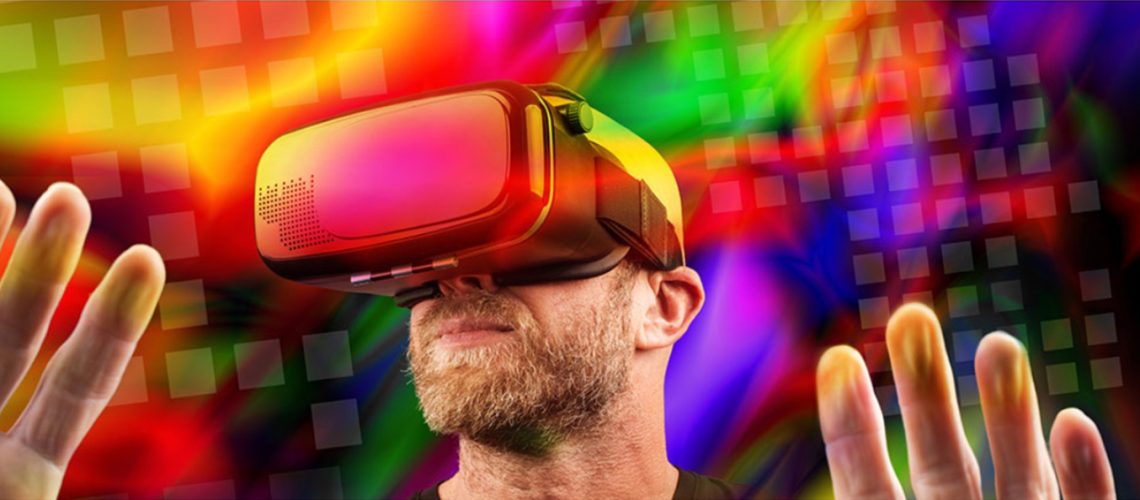What is Immersive video and how is it evolving? Immersive video can be presented in a number of ways. 360-degree videos, 3D videos, multiscreen projections, and reflections all produce different immersive experiences. Virtual reality, augmented reality, and mixed reality also populate the immersive video menu.
Immersive Video and Virtual Reality
Creating an immersive experience means you are enabling a viewer of your content the ability to suspend belief of where they are in reality and supplement that with a virtual reality experience. What a viewer or an audience considers immersive is also dependent upon the era that a particular technology is being deployed. Seeing an 1896 Lumière brothers film of a train arriving at a station would not cause anyone to bat an eye today, but at the time was considered surprising, shocking and immersive.
Zach Robbins, a digital strategist with Viget, @viget an interactive agency that focuses on designing and developing content for the web, puts it this way: “I would define VR as any experience where the user is placed inside of a space. The more that you control, the more immersive it is. It’s definitely possible to have an immersive VR experience without a super expensive device or any device at all, as long as you are putting control in the user’s hands in terms of the way that they engage with the story, where they go and where they look. The level of immersion really just depends on the level of production. So, obviously your Oculus will have much more immersion then if you are just using Google cardboard. At the same time, I would still say that a YouTube 360-degree video is some form of VR.”
You can also check out the entire channel here.
Author Lasse Rouhiainen, @lasseweb20 is excited about the evolution of immersive video and VR and their application in the business world. “The number one format of marketing and communication online is video,” Lasse reminds us. “Now we are getting new forms of video, including 360 video which is amazing. This will transform many things like traveling, real estate, marketing, education and many other areas. It is really interesting because we can use virtual reality goggles or glasses and we can immerse in new ways.”
Robbins expressed personal interest in VR as it relates to immersive experiences. “We are brainstorming more with clients about how to leverage media in an interactive environment to connect to audiences in a different way. Recently, VR has become more in our radar as it pertains to being accessible on the web and being accessible to more people as they don’t have to shell out a lot of money in order to engage with VR content.”
VR content can now be integrated directly into browsers with browser support through Web VR. Robbins explained that this opens up the possibility of integration with a lot of different technologies and libraries. “Whereas you would have had to otherwise have proprietary software to build 3D environments and then display it, now you can do that with code using Javascript like 3JS, using Web VR to display a dual video approach for VR devices like cardboard or Samsung Gear VR.”
Zach Robbins of Viget discusses VR browser integration and Web VR.
Robbins was excited that publishers like the New York Times have invested in distributing smartphone-based VR cardboard viewers to all their subscribers. As more content publishers get involved in VR content distribution, cardboard viewers will become much more of a share of the market for everyone that has a smartphone. As the new and experimental projects become popular, everybody will start to catch up and see the application for VR in their particular field, Robbins predicted. “The market is growing in terms of the customers that can actually reach and engage with that content. It will become a second nature form of content like video that we engage with now, just VR as well.” There is definitely an audience. There are already over 1 million Samsung Gear VRs in circulation.
Ryan Steinolfson, President of Accelerate Marketing @RyanSteinolfson was excited about this new form of engaging audiences: “When I produce a video and I let the person experience what I’m doing as if through my eyes and it is engaging and immersive, then the result is magic. My engagement goes through the roof when I do things like that. It is good to be different and that’s what people react to and engage with. There are all kinds of opportunities for event planners or for people putting on produced events or concerts. It’s open to whatever your creativity allows you to do.”
Futurist Mitch Joel, President of Mirum, a global digital marketing agency @mitchjoel has seen a big push in terms of press and public relations. “You have lots of brands that are jumping into virtual reality and augmented reality simply to be the ones saying we’re here, we’re first, we’re active in it. The other side that we are seeing a lot of is training. Brands are using this to augment their training experiences, whether training their executives to be comfortable in front of an audience, or the military to experience war-torn areas before they are actually immersed in them physically.”
Rouhiainen sees VR and AR as a new emotional way of selling. “Real estate people can provide customers a way to feel what it would be like to be inside your new home. In society, this has a huge impact, with some only meeting in a virtual reality, but never meeting in the real world. There will be many implications, but most of it is extremely positive. I highly recommend all companies learn about it as soon as they can, otherwise they could miss some opportunities.”
Augmented Reality
Augmented reality is a form of supplementing the real world with things like annotations or graphical overlays. It has been around for a while as Google Glass can attest to, but augmented reality is not sitting still, it continues to evolve. “Augmented reality is actually more interesting,” confessed Rouhiainen. “In virtual reality, with a headset, you are in one place experiencing a virtual environment, whereas, with augmented reality, we augment the reality we see.”
According to Robbins, “Augmented reality will become even more prominent if we can think about all the ways in which we can remove or reduce the barriers to entry and the barriers to asking anyone to engage with that type of content. For example, a museum might have a device or turn-key system right there at the display vs asking the user to get their phone out, download a native application, log into the app, pull up their phone, open up their camera and allow acces. If we can just provide devices that specifically engage with a particular display, and remove barriers to entry, the more things like immersive reality experiences, especially for in store or in person display, become more possible.”
The most well know use case of augmented reality is the Pokémon GO game. Rouhiainen predicts that augmented reality will be bigger than virtual reality in some ways with new different types of learning games and marketing uses. The new Apple iPhone for next year is rumored to have augmented reality technology integrated into the iPhone’s camera app.
Mixed Reality
Facebook acquired Oculus VR and has been doing some amazing things in the VR, AR and mixed reality space. Steinolfson was ecstatic when he saw the VR demo that Mark Zuckerberg presented at Oculus Connect. Said Steinolfson, “Augmented reality is amazing and that Mark Zuckerberg presentation blew me away. It is mind boggling what you can do.” In this presentation, the virtual Mark interacted with his teleconferenced wife, took a selfie and uploaded to Facebook, all the while in the augmented reality environment.
Mark Zuckerberg and Oculus’s Michael Abrash on Why Virtual Reality Is the Next Big Thing
“Mixed Reality is, even more, mind blowing,” Rouhiainen expressed. “You see reality mixed with virtual reality. Microsoft describes it as Hologram integration.”
Incidentally, having made holograms on glass plates, I have a bit of a beef about everybody calling anything dimensional a hologram. A true hologram is actually the capture and reassembly of intersecting light waves that reveal a three-dimensional image. The basis of holography is that the interference pattern created by these light waves is what is actually captured and displayed.
In some ways, the method in which a Lytro camera captures light is closer to a hologram than the dead celebrity “holograms” from Hologram USA and Pulse Evolution. These dead celebrity “holograms” are really an optical illusion known as “Pepper’s Ghost.” Essentially, it is a 2D image reflected off an angled piece of plastic film or plexiglass.
But alas, the popular use of the word hologram is something I will have to let go of, and besides who could not get excited by Microsoft’s HoloLens, which Microsoft describes as the first self-contained holographic computer.
Another company that is developing a fascinating mixed reality product is called Magic Leap. Even though they are still a start-up, they were able to raise close to a billion dollars with a valuation of 4.5 billion dollars!
What’s next?
Robbins would like to see VR being used as a primary source for education. “I think that a lot of times education is little far behind when it comes to technology. The way that schools adopt technology, the way that higher ed adopts technology. I would love to see them on the cutting edge of taking students out of the classroom and getting them to engage with topics like science, history and archeology in a completely different way from them reading a textbook. So, I’d love for it to be a definition of how kids and college students learn and how we study things about humanity, history and about other subjects and topics.”
As Steinolfson notes, “It is up to your creativity as far as what you want to do with it and how creative you want to be with it. My suggestion is to go out there and explore these tools, use them and show people your passion and let people into your world leveraging these tools. That’s the magic that I have discovered with all this stuff.”
Subscribe to our BLOG
Stay in touch & learn how to attract customers, become a thought leader, create effective marketing campaigns, & more.





